Report: Psychological Phenomenon and Employee Satisfaction Research
VerifiedAdded on 2021/02/20
|10
|3174
|462
Report
AI Summary
This report provides a critical analysis of research related to psychological phenomena and employee satisfaction. It begins with an introduction to contemporary business issues and the importance of understanding employee needs and motivations. The main body delves into Maslow's Hierarchy of Needs theory, exploring its five levels and how they impact employee behavior and job satisfaction. The report identifies a research topic related to the theory and formulates research questions. It then examines different research methodologies, including qualitative and quantitative approaches, with a justification for selecting qualitative research for the given questions. A reflective model is used to demonstrate an understanding of the research process, referencing various academic sources to support the analysis. The report concludes by summarizing the key findings and insights gained from the research.
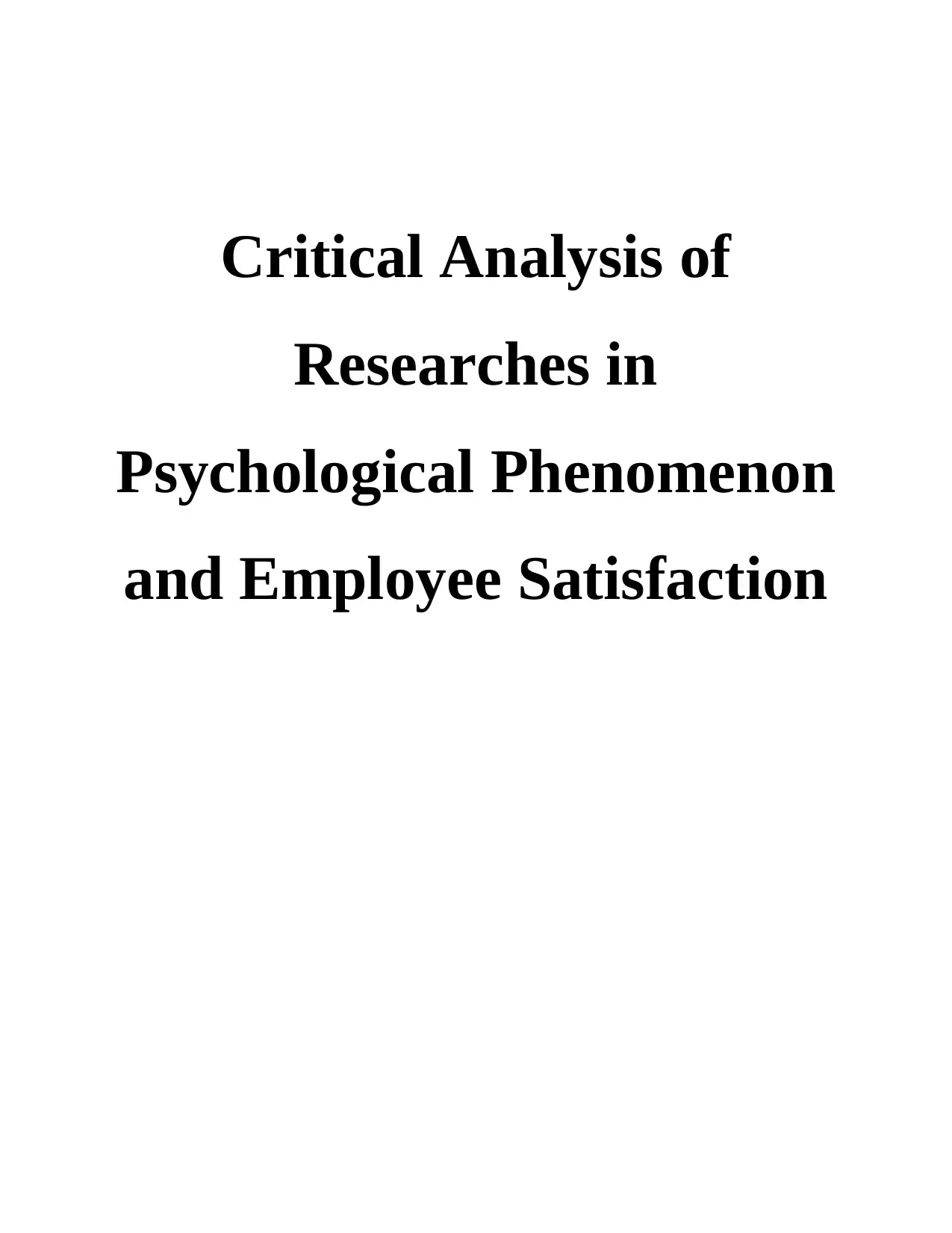
Critical Analysis of
Researches in
Psychological Phenomenon
and Employee Satisfaction
Researches in
Psychological Phenomenon
and Employee Satisfaction
Paraphrase This Document
Need a fresh take? Get an instant paraphrase of this document with our AI Paraphraser
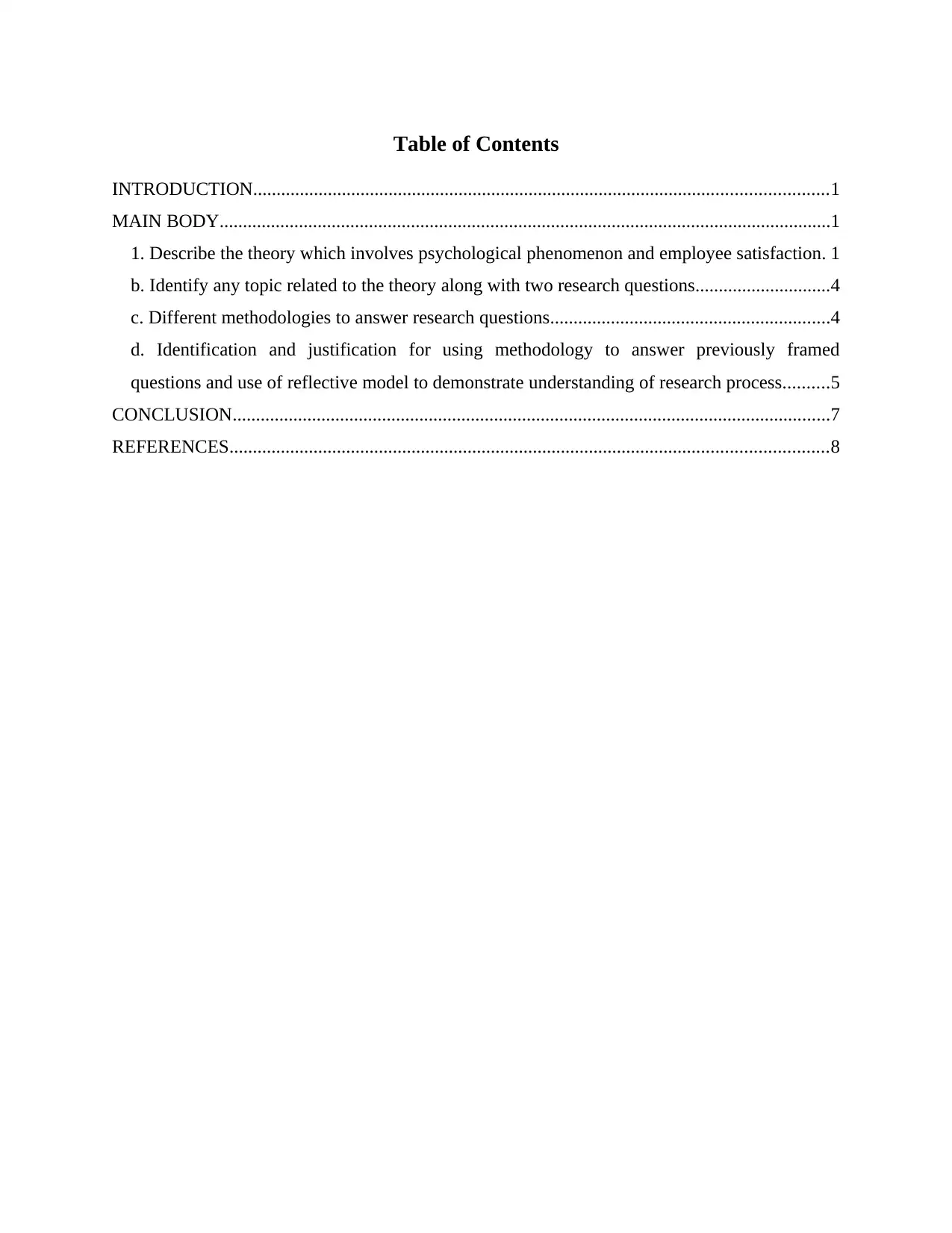
Table of Contents
INTRODUCTION...........................................................................................................................1
MAIN BODY...................................................................................................................................1
1. Describe the theory which involves psychological phenomenon and employee satisfaction. 1
b. Identify any topic related to the theory along with two research questions.............................4
c. Different methodologies to answer research questions............................................................4
d. Identification and justification for using methodology to answer previously framed
questions and use of reflective model to demonstrate understanding of research process..........5
CONCLUSION................................................................................................................................7
REFERENCES................................................................................................................................8
INTRODUCTION...........................................................................................................................1
MAIN BODY...................................................................................................................................1
1. Describe the theory which involves psychological phenomenon and employee satisfaction. 1
b. Identify any topic related to the theory along with two research questions.............................4
c. Different methodologies to answer research questions............................................................4
d. Identification and justification for using methodology to answer previously framed
questions and use of reflective model to demonstrate understanding of research process..........5
CONCLUSION................................................................................................................................7
REFERENCES................................................................................................................................8
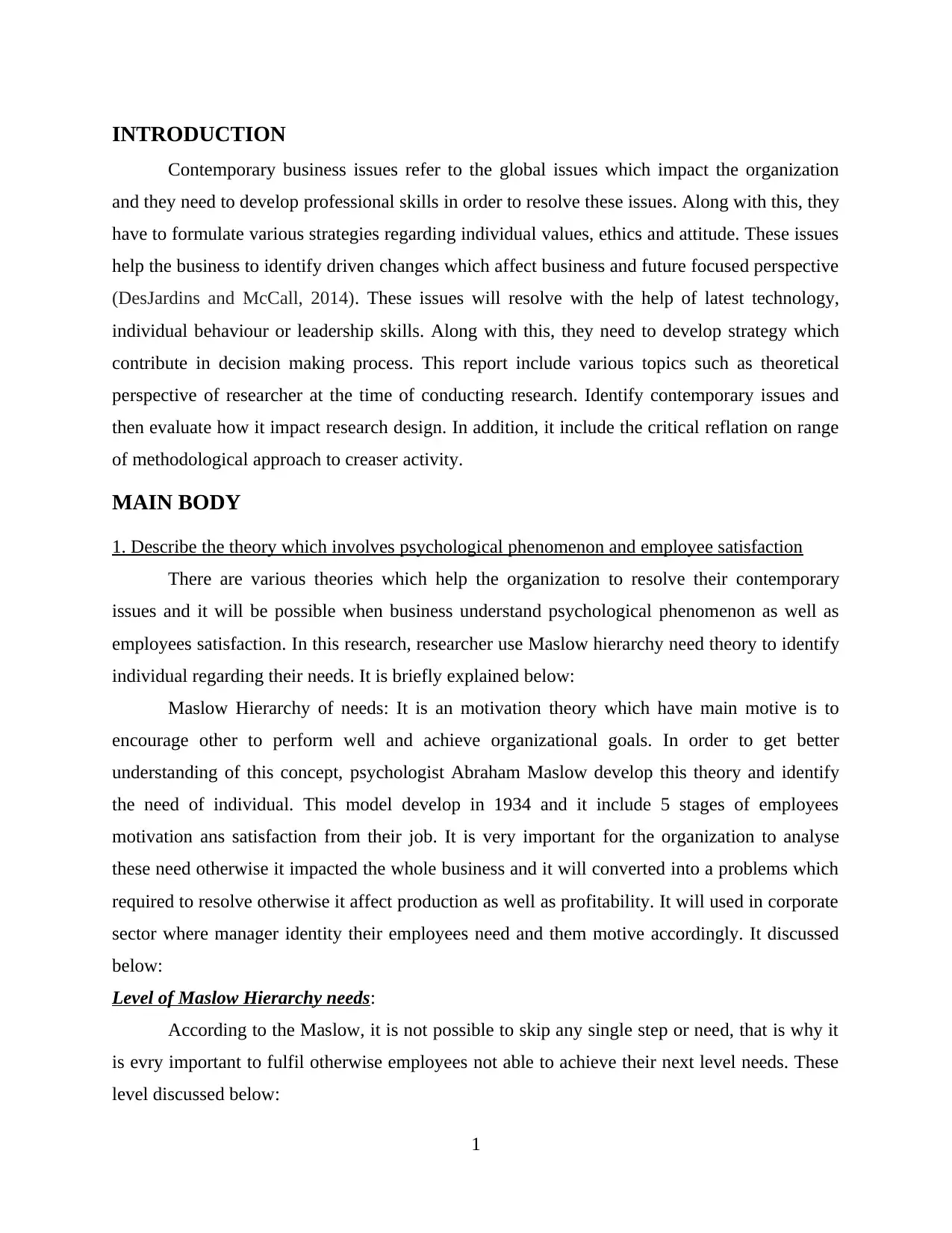
INTRODUCTION
Contemporary business issues refer to the global issues which impact the organization
and they need to develop professional skills in order to resolve these issues. Along with this, they
have to formulate various strategies regarding individual values, ethics and attitude. These issues
help the business to identify driven changes which affect business and future focused perspective
(DesJardins and McCall, 2014). These issues will resolve with the help of latest technology,
individual behaviour or leadership skills. Along with this, they need to develop strategy which
contribute in decision making process. This report include various topics such as theoretical
perspective of researcher at the time of conducting research. Identify contemporary issues and
then evaluate how it impact research design. In addition, it include the critical reflation on range
of methodological approach to creaser activity.
MAIN BODY
1. Describe the theory which involves psychological phenomenon and employee satisfaction
There are various theories which help the organization to resolve their contemporary
issues and it will be possible when business understand psychological phenomenon as well as
employees satisfaction. In this research, researcher use Maslow hierarchy need theory to identify
individual regarding their needs. It is briefly explained below:
Maslow Hierarchy of needs: It is an motivation theory which have main motive is to
encourage other to perform well and achieve organizational goals. In order to get better
understanding of this concept, psychologist Abraham Maslow develop this theory and identify
the need of individual. This model develop in 1934 and it include 5 stages of employees
motivation ans satisfaction from their job. It is very important for the organization to analyse
these need otherwise it impacted the whole business and it will converted into a problems which
required to resolve otherwise it affect production as well as profitability. It will used in corporate
sector where manager identity their employees need and them motive accordingly. It discussed
below:
Level of Maslow Hierarchy needs:
According to the Maslow, it is not possible to skip any single step or need, that is why it
is evry important to fulfil otherwise employees not able to achieve their next level needs. These
level discussed below:
1
Contemporary business issues refer to the global issues which impact the organization
and they need to develop professional skills in order to resolve these issues. Along with this, they
have to formulate various strategies regarding individual values, ethics and attitude. These issues
help the business to identify driven changes which affect business and future focused perspective
(DesJardins and McCall, 2014). These issues will resolve with the help of latest technology,
individual behaviour or leadership skills. Along with this, they need to develop strategy which
contribute in decision making process. This report include various topics such as theoretical
perspective of researcher at the time of conducting research. Identify contemporary issues and
then evaluate how it impact research design. In addition, it include the critical reflation on range
of methodological approach to creaser activity.
MAIN BODY
1. Describe the theory which involves psychological phenomenon and employee satisfaction
There are various theories which help the organization to resolve their contemporary
issues and it will be possible when business understand psychological phenomenon as well as
employees satisfaction. In this research, researcher use Maslow hierarchy need theory to identify
individual regarding their needs. It is briefly explained below:
Maslow Hierarchy of needs: It is an motivation theory which have main motive is to
encourage other to perform well and achieve organizational goals. In order to get better
understanding of this concept, psychologist Abraham Maslow develop this theory and identify
the need of individual. This model develop in 1934 and it include 5 stages of employees
motivation ans satisfaction from their job. It is very important for the organization to analyse
these need otherwise it impacted the whole business and it will converted into a problems which
required to resolve otherwise it affect production as well as profitability. It will used in corporate
sector where manager identity their employees need and them motive accordingly. It discussed
below:
Level of Maslow Hierarchy needs:
According to the Maslow, it is not possible to skip any single step or need, that is why it
is evry important to fulfil otherwise employees not able to achieve their next level needs. These
level discussed below:
1
⊘ This is a preview!⊘
Do you want full access?
Subscribe today to unlock all pages.

Trusted by 1+ million students worldwide
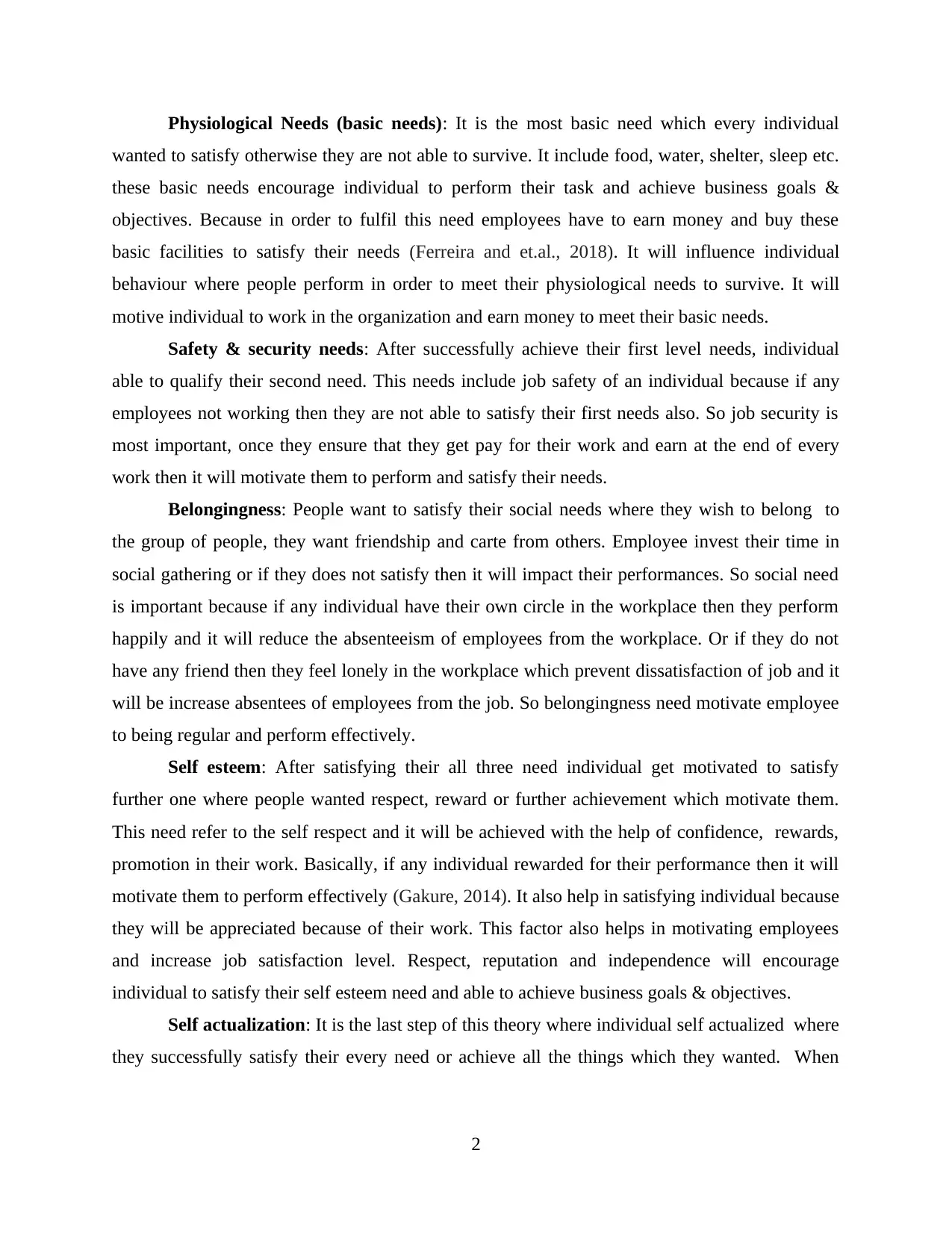
Physiological Needs (basic needs): It is the most basic need which every individual
wanted to satisfy otherwise they are not able to survive. It include food, water, shelter, sleep etc.
these basic needs encourage individual to perform their task and achieve business goals &
objectives. Because in order to fulfil this need employees have to earn money and buy these
basic facilities to satisfy their needs (Ferreira and et.al., 2018). It will influence individual
behaviour where people perform in order to meet their physiological needs to survive. It will
motive individual to work in the organization and earn money to meet their basic needs.
Safety & security needs: After successfully achieve their first level needs, individual
able to qualify their second need. This needs include job safety of an individual because if any
employees not working then they are not able to satisfy their first needs also. So job security is
most important, once they ensure that they get pay for their work and earn at the end of every
work then it will motivate them to perform and satisfy their needs.
Belongingness: People want to satisfy their social needs where they wish to belong to
the group of people, they want friendship and carte from others. Employee invest their time in
social gathering or if they does not satisfy then it will impact their performances. So social need
is important because if any individual have their own circle in the workplace then they perform
happily and it will reduce the absenteeism of employees from the workplace. Or if they do not
have any friend then they feel lonely in the workplace which prevent dissatisfaction of job and it
will be increase absentees of employees from the job. So belongingness need motivate employee
to being regular and perform effectively.
Self esteem: After satisfying their all three need individual get motivated to satisfy
further one where people wanted respect, reward or further achievement which motivate them.
This need refer to the self respect and it will be achieved with the help of confidence, rewards,
promotion in their work. Basically, if any individual rewarded for their performance then it will
motivate them to perform effectively (Gakure, 2014). It also help in satisfying individual because
they will be appreciated because of their work. This factor also helps in motivating employees
and increase job satisfaction level. Respect, reputation and independence will encourage
individual to satisfy their self esteem need and able to achieve business goals & objectives.
Self actualization: It is the last step of this theory where individual self actualized where
they successfully satisfy their every need or achieve all the things which they wanted. When
2
wanted to satisfy otherwise they are not able to survive. It include food, water, shelter, sleep etc.
these basic needs encourage individual to perform their task and achieve business goals &
objectives. Because in order to fulfil this need employees have to earn money and buy these
basic facilities to satisfy their needs (Ferreira and et.al., 2018). It will influence individual
behaviour where people perform in order to meet their physiological needs to survive. It will
motive individual to work in the organization and earn money to meet their basic needs.
Safety & security needs: After successfully achieve their first level needs, individual
able to qualify their second need. This needs include job safety of an individual because if any
employees not working then they are not able to satisfy their first needs also. So job security is
most important, once they ensure that they get pay for their work and earn at the end of every
work then it will motivate them to perform and satisfy their needs.
Belongingness: People want to satisfy their social needs where they wish to belong to
the group of people, they want friendship and carte from others. Employee invest their time in
social gathering or if they does not satisfy then it will impact their performances. So social need
is important because if any individual have their own circle in the workplace then they perform
happily and it will reduce the absenteeism of employees from the workplace. Or if they do not
have any friend then they feel lonely in the workplace which prevent dissatisfaction of job and it
will be increase absentees of employees from the job. So belongingness need motivate employee
to being regular and perform effectively.
Self esteem: After satisfying their all three need individual get motivated to satisfy
further one where people wanted respect, reward or further achievement which motivate them.
This need refer to the self respect and it will be achieved with the help of confidence, rewards,
promotion in their work. Basically, if any individual rewarded for their performance then it will
motivate them to perform effectively (Gakure, 2014). It also help in satisfying individual because
they will be appreciated because of their work. This factor also helps in motivating employees
and increase job satisfaction level. Respect, reputation and independence will encourage
individual to satisfy their self esteem need and able to achieve business goals & objectives.
Self actualization: It is the last step of this theory where individual self actualized where
they successfully satisfy their every need or achieve all the things which they wanted. When
2
Paraphrase This Document
Need a fresh take? Get an instant paraphrase of this document with our AI Paraphraser
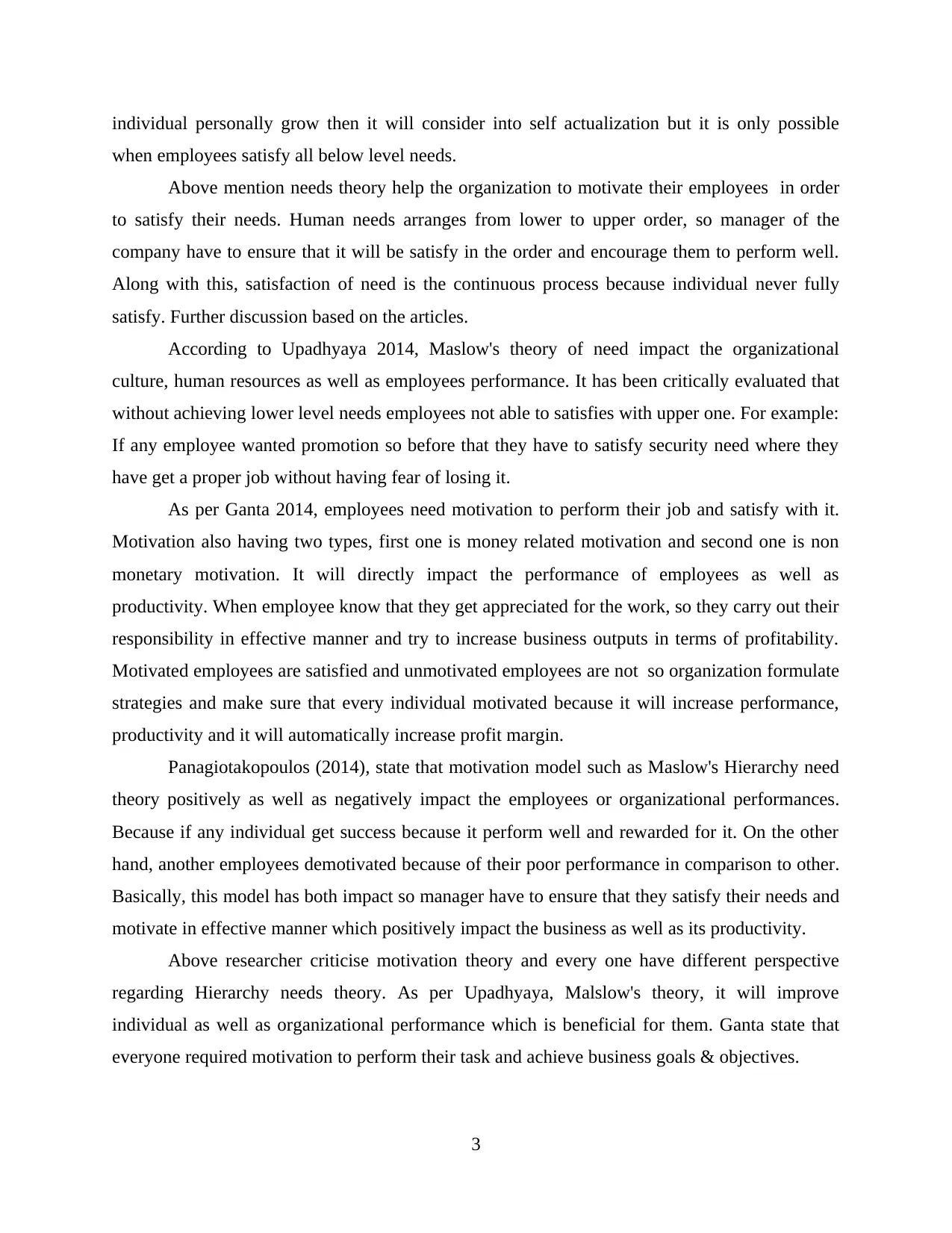
individual personally grow then it will consider into self actualization but it is only possible
when employees satisfy all below level needs.
Above mention needs theory help the organization to motivate their employees in order
to satisfy their needs. Human needs arranges from lower to upper order, so manager of the
company have to ensure that it will be satisfy in the order and encourage them to perform well.
Along with this, satisfaction of need is the continuous process because individual never fully
satisfy. Further discussion based on the articles.
According to Upadhyaya 2014, Maslow's theory of need impact the organizational
culture, human resources as well as employees performance. It has been critically evaluated that
without achieving lower level needs employees not able to satisfies with upper one. For example:
If any employee wanted promotion so before that they have to satisfy security need where they
have get a proper job without having fear of losing it.
As per Ganta 2014, employees need motivation to perform their job and satisfy with it.
Motivation also having two types, first one is money related motivation and second one is non
monetary motivation. It will directly impact the performance of employees as well as
productivity. When employee know that they get appreciated for the work, so they carry out their
responsibility in effective manner and try to increase business outputs in terms of profitability.
Motivated employees are satisfied and unmotivated employees are not so organization formulate
strategies and make sure that every individual motivated because it will increase performance,
productivity and it will automatically increase profit margin.
Panagiotakopoulos (2014), state that motivation model such as Maslow's Hierarchy need
theory positively as well as negatively impact the employees or organizational performances.
Because if any individual get success because it perform well and rewarded for it. On the other
hand, another employees demotivated because of their poor performance in comparison to other.
Basically, this model has both impact so manager have to ensure that they satisfy their needs and
motivate in effective manner which positively impact the business as well as its productivity.
Above researcher criticise motivation theory and every one have different perspective
regarding Hierarchy needs theory. As per Upadhyaya, Malslow's theory, it will improve
individual as well as organizational performance which is beneficial for them. Ganta state that
everyone required motivation to perform their task and achieve business goals & objectives.
3
when employees satisfy all below level needs.
Above mention needs theory help the organization to motivate their employees in order
to satisfy their needs. Human needs arranges from lower to upper order, so manager of the
company have to ensure that it will be satisfy in the order and encourage them to perform well.
Along with this, satisfaction of need is the continuous process because individual never fully
satisfy. Further discussion based on the articles.
According to Upadhyaya 2014, Maslow's theory of need impact the organizational
culture, human resources as well as employees performance. It has been critically evaluated that
without achieving lower level needs employees not able to satisfies with upper one. For example:
If any employee wanted promotion so before that they have to satisfy security need where they
have get a proper job without having fear of losing it.
As per Ganta 2014, employees need motivation to perform their job and satisfy with it.
Motivation also having two types, first one is money related motivation and second one is non
monetary motivation. It will directly impact the performance of employees as well as
productivity. When employee know that they get appreciated for the work, so they carry out their
responsibility in effective manner and try to increase business outputs in terms of profitability.
Motivated employees are satisfied and unmotivated employees are not so organization formulate
strategies and make sure that every individual motivated because it will increase performance,
productivity and it will automatically increase profit margin.
Panagiotakopoulos (2014), state that motivation model such as Maslow's Hierarchy need
theory positively as well as negatively impact the employees or organizational performances.
Because if any individual get success because it perform well and rewarded for it. On the other
hand, another employees demotivated because of their poor performance in comparison to other.
Basically, this model has both impact so manager have to ensure that they satisfy their needs and
motivate in effective manner which positively impact the business as well as its productivity.
Above researcher criticise motivation theory and every one have different perspective
regarding Hierarchy needs theory. As per Upadhyaya, Malslow's theory, it will improve
individual as well as organizational performance which is beneficial for them. Ganta state that
everyone required motivation to perform their task and achieve business goals & objectives.
3

b. Identify any topic related to the theory along with two research questions
Topic: “ Impact of Mashlo's Hierarchy Needs theory on employees motivation”
Research Questions:
1. What is Mashlo's Hierarchy Needs theory?
2. Impact of Maslow's theory on employees motivational level?
c. Different methodologies to answer research questions
Research methodology: It can be defined as the technique which is used by researchers
to gather, evaluate and collect information so that answers of all the research questions could be
provided. With the help of it problems which are analysed by the researcher could be answered
appropriately. There are two major types of methodologies for research which is used to answer
the questions. Both of them are described below:
Qualitative research methodology: This methodology is mainly based on the academic
projects, journals and articles. It is mainly used in the projects of social sciences, study of
theoretical models and market based researches (Moncrief, Marshall and Rudd, 2015). It is
mainly focused with the process of obtaining information with the help of conversational and
open ended communication. All the information which is used in it is non numerical which
makes the research process easy. It could be used to answer the research questions because
detailed information for them could be analysed with the help of it.
Quantitative research methodology: It is mainly based upon numerical information in
which statistical and computational techniques are used to find solution for research problems.
Main aim of it is to develop mathematical models so that hypothesis could be studied. In order to
answer the present research questions this methodology could be used as it can help researcher to
gather information through different mediums such as survey, questionnaire etc.
Comparison of both the methodologies:
Basis Qualitative research methodology Quantitative research
methodology
Strengths With the help of it researcher can
collect detailed information to define
the complex problem. It complements
and refine the information which is
All the findings in this method could be
generalised if the process which is
followed to find the results is designed
properly (Strengths and weaknesses of
4
Topic: “ Impact of Mashlo's Hierarchy Needs theory on employees motivation”
Research Questions:
1. What is Mashlo's Hierarchy Needs theory?
2. Impact of Maslow's theory on employees motivational level?
c. Different methodologies to answer research questions
Research methodology: It can be defined as the technique which is used by researchers
to gather, evaluate and collect information so that answers of all the research questions could be
provided. With the help of it problems which are analysed by the researcher could be answered
appropriately. There are two major types of methodologies for research which is used to answer
the questions. Both of them are described below:
Qualitative research methodology: This methodology is mainly based on the academic
projects, journals and articles. It is mainly used in the projects of social sciences, study of
theoretical models and market based researches (Moncrief, Marshall and Rudd, 2015). It is
mainly focused with the process of obtaining information with the help of conversational and
open ended communication. All the information which is used in it is non numerical which
makes the research process easy. It could be used to answer the research questions because
detailed information for them could be analysed with the help of it.
Quantitative research methodology: It is mainly based upon numerical information in
which statistical and computational techniques are used to find solution for research problems.
Main aim of it is to develop mathematical models so that hypothesis could be studied. In order to
answer the present research questions this methodology could be used as it can help researcher to
gather information through different mediums such as survey, questionnaire etc.
Comparison of both the methodologies:
Basis Qualitative research methodology Quantitative research
methodology
Strengths With the help of it researcher can
collect detailed information to define
the complex problem. It complements
and refine the information which is
All the findings in this method could be
generalised if the process which is
followed to find the results is designed
properly (Strengths and weaknesses of
4
⊘ This is a preview!⊘
Do you want full access?
Subscribe today to unlock all pages.

Trusted by 1+ million students worldwide
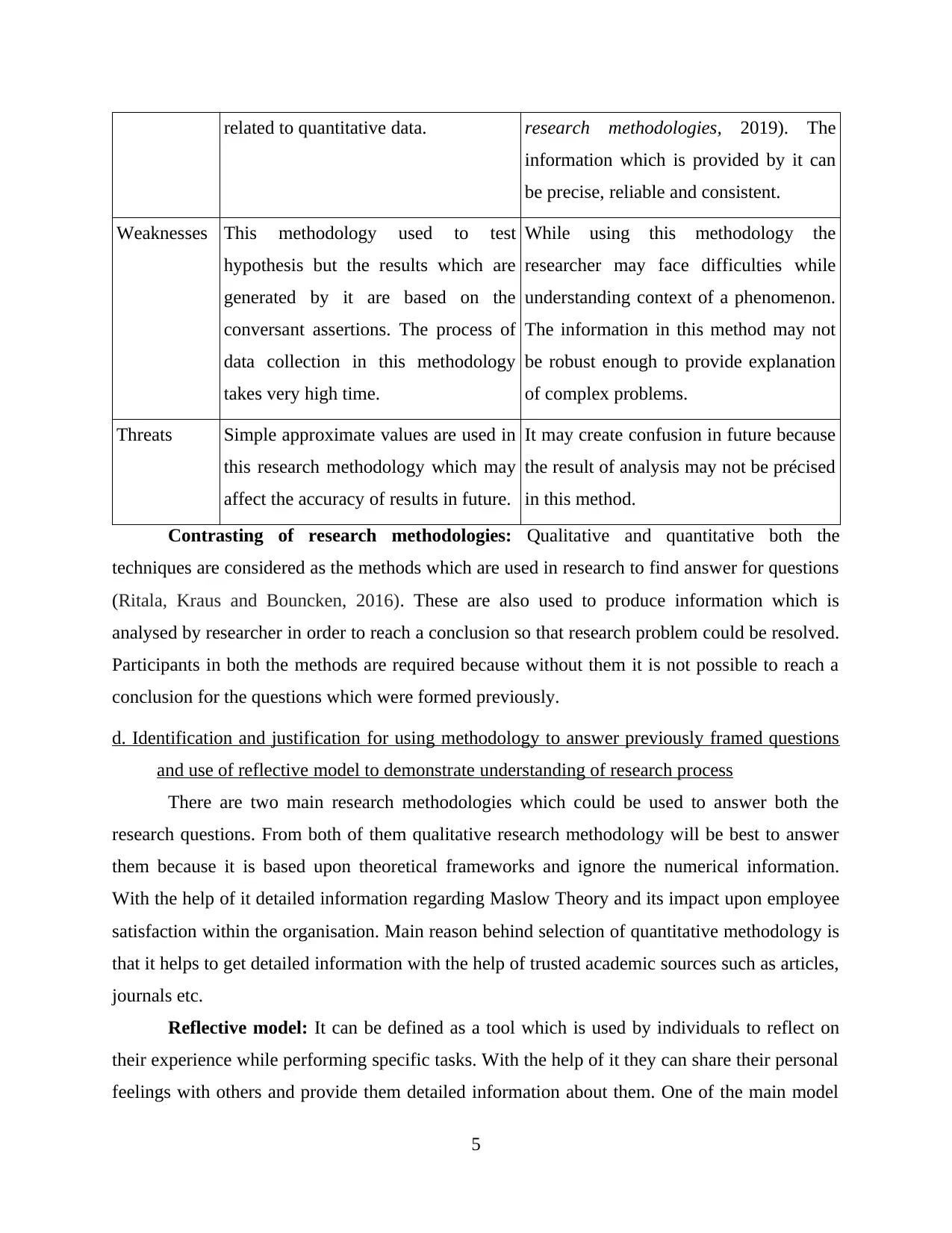
related to quantitative data. research methodologies, 2019). The
information which is provided by it can
be precise, reliable and consistent.
Weaknesses This methodology used to test
hypothesis but the results which are
generated by it are based on the
conversant assertions. The process of
data collection in this methodology
takes very high time.
While using this methodology the
researcher may face difficulties while
understanding context of a phenomenon.
The information in this method may not
be robust enough to provide explanation
of complex problems.
Threats Simple approximate values are used in
this research methodology which may
affect the accuracy of results in future.
It may create confusion in future because
the result of analysis may not be précised
in this method.
Contrasting of research methodologies: Qualitative and quantitative both the
techniques are considered as the methods which are used in research to find answer for questions
(Ritala, Kraus and Bouncken, 2016). These are also used to produce information which is
analysed by researcher in order to reach a conclusion so that research problem could be resolved.
Participants in both the methods are required because without them it is not possible to reach a
conclusion for the questions which were formed previously.
d. Identification and justification for using methodology to answer previously framed questions
and use of reflective model to demonstrate understanding of research process
There are two main research methodologies which could be used to answer both the
research questions. From both of them qualitative research methodology will be best to answer
them because it is based upon theoretical frameworks and ignore the numerical information.
With the help of it detailed information regarding Maslow Theory and its impact upon employee
satisfaction within the organisation. Main reason behind selection of quantitative methodology is
that it helps to get detailed information with the help of trusted academic sources such as articles,
journals etc.
Reflective model: It can be defined as a tool which is used by individuals to reflect on
their experience while performing specific tasks. With the help of it they can share their personal
feelings with others and provide them detailed information about them. One of the main model
5
information which is provided by it can
be precise, reliable and consistent.
Weaknesses This methodology used to test
hypothesis but the results which are
generated by it are based on the
conversant assertions. The process of
data collection in this methodology
takes very high time.
While using this methodology the
researcher may face difficulties while
understanding context of a phenomenon.
The information in this method may not
be robust enough to provide explanation
of complex problems.
Threats Simple approximate values are used in
this research methodology which may
affect the accuracy of results in future.
It may create confusion in future because
the result of analysis may not be précised
in this method.
Contrasting of research methodologies: Qualitative and quantitative both the
techniques are considered as the methods which are used in research to find answer for questions
(Ritala, Kraus and Bouncken, 2016). These are also used to produce information which is
analysed by researcher in order to reach a conclusion so that research problem could be resolved.
Participants in both the methods are required because without them it is not possible to reach a
conclusion for the questions which were formed previously.
d. Identification and justification for using methodology to answer previously framed questions
and use of reflective model to demonstrate understanding of research process
There are two main research methodologies which could be used to answer both the
research questions. From both of them qualitative research methodology will be best to answer
them because it is based upon theoretical frameworks and ignore the numerical information.
With the help of it detailed information regarding Maslow Theory and its impact upon employee
satisfaction within the organisation. Main reason behind selection of quantitative methodology is
that it helps to get detailed information with the help of trusted academic sources such as articles,
journals etc.
Reflective model: It can be defined as a tool which is used by individuals to reflect on
their experience while performing specific tasks. With the help of it they can share their personal
feelings with others and provide them detailed information about them. One of the main model
5
Paraphrase This Document
Need a fresh take? Get an instant paraphrase of this document with our AI Paraphraser
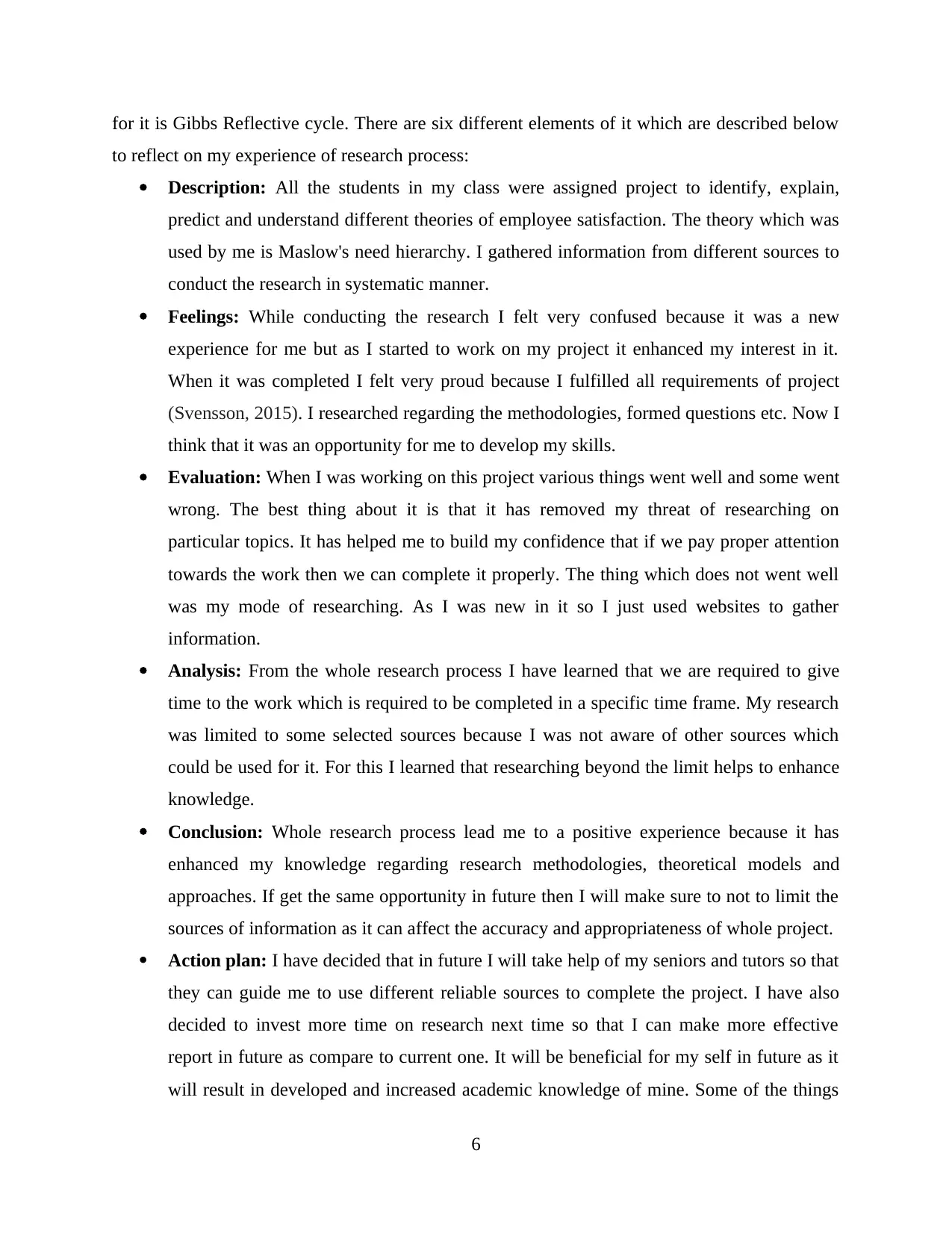
for it is Gibbs Reflective cycle. There are six different elements of it which are described below
to reflect on my experience of research process:
Description: All the students in my class were assigned project to identify, explain,
predict and understand different theories of employee satisfaction. The theory which was
used by me is Maslow's need hierarchy. I gathered information from different sources to
conduct the research in systematic manner.
Feelings: While conducting the research I felt very confused because it was a new
experience for me but as I started to work on my project it enhanced my interest in it.
When it was completed I felt very proud because I fulfilled all requirements of project
(Svensson, 2015). I researched regarding the methodologies, formed questions etc. Now I
think that it was an opportunity for me to develop my skills.
Evaluation: When I was working on this project various things went well and some went
wrong. The best thing about it is that it has removed my threat of researching on
particular topics. It has helped me to build my confidence that if we pay proper attention
towards the work then we can complete it properly. The thing which does not went well
was my mode of researching. As I was new in it so I just used websites to gather
information.
Analysis: From the whole research process I have learned that we are required to give
time to the work which is required to be completed in a specific time frame. My research
was limited to some selected sources because I was not aware of other sources which
could be used for it. For this I learned that researching beyond the limit helps to enhance
knowledge.
Conclusion: Whole research process lead me to a positive experience because it has
enhanced my knowledge regarding research methodologies, theoretical models and
approaches. If get the same opportunity in future then I will make sure to not to limit the
sources of information as it can affect the accuracy and appropriateness of whole project.
Action plan: I have decided that in future I will take help of my seniors and tutors so that
they can guide me to use different reliable sources to complete the project. I have also
decided to invest more time on research next time so that I can make more effective
report in future as compare to current one. It will be beneficial for my self in future as it
will result in developed and increased academic knowledge of mine. Some of the things
6
to reflect on my experience of research process:
Description: All the students in my class were assigned project to identify, explain,
predict and understand different theories of employee satisfaction. The theory which was
used by me is Maslow's need hierarchy. I gathered information from different sources to
conduct the research in systematic manner.
Feelings: While conducting the research I felt very confused because it was a new
experience for me but as I started to work on my project it enhanced my interest in it.
When it was completed I felt very proud because I fulfilled all requirements of project
(Svensson, 2015). I researched regarding the methodologies, formed questions etc. Now I
think that it was an opportunity for me to develop my skills.
Evaluation: When I was working on this project various things went well and some went
wrong. The best thing about it is that it has removed my threat of researching on
particular topics. It has helped me to build my confidence that if we pay proper attention
towards the work then we can complete it properly. The thing which does not went well
was my mode of researching. As I was new in it so I just used websites to gather
information.
Analysis: From the whole research process I have learned that we are required to give
time to the work which is required to be completed in a specific time frame. My research
was limited to some selected sources because I was not aware of other sources which
could be used for it. For this I learned that researching beyond the limit helps to enhance
knowledge.
Conclusion: Whole research process lead me to a positive experience because it has
enhanced my knowledge regarding research methodologies, theoretical models and
approaches. If get the same opportunity in future then I will make sure to not to limit the
sources of information as it can affect the accuracy and appropriateness of whole project.
Action plan: I have decided that in future I will take help of my seniors and tutors so that
they can guide me to use different reliable sources to complete the project. I have also
decided to invest more time on research next time so that I can make more effective
report in future as compare to current one. It will be beneficial for my self in future as it
will result in developed and increased academic knowledge of mine. Some of the things
6
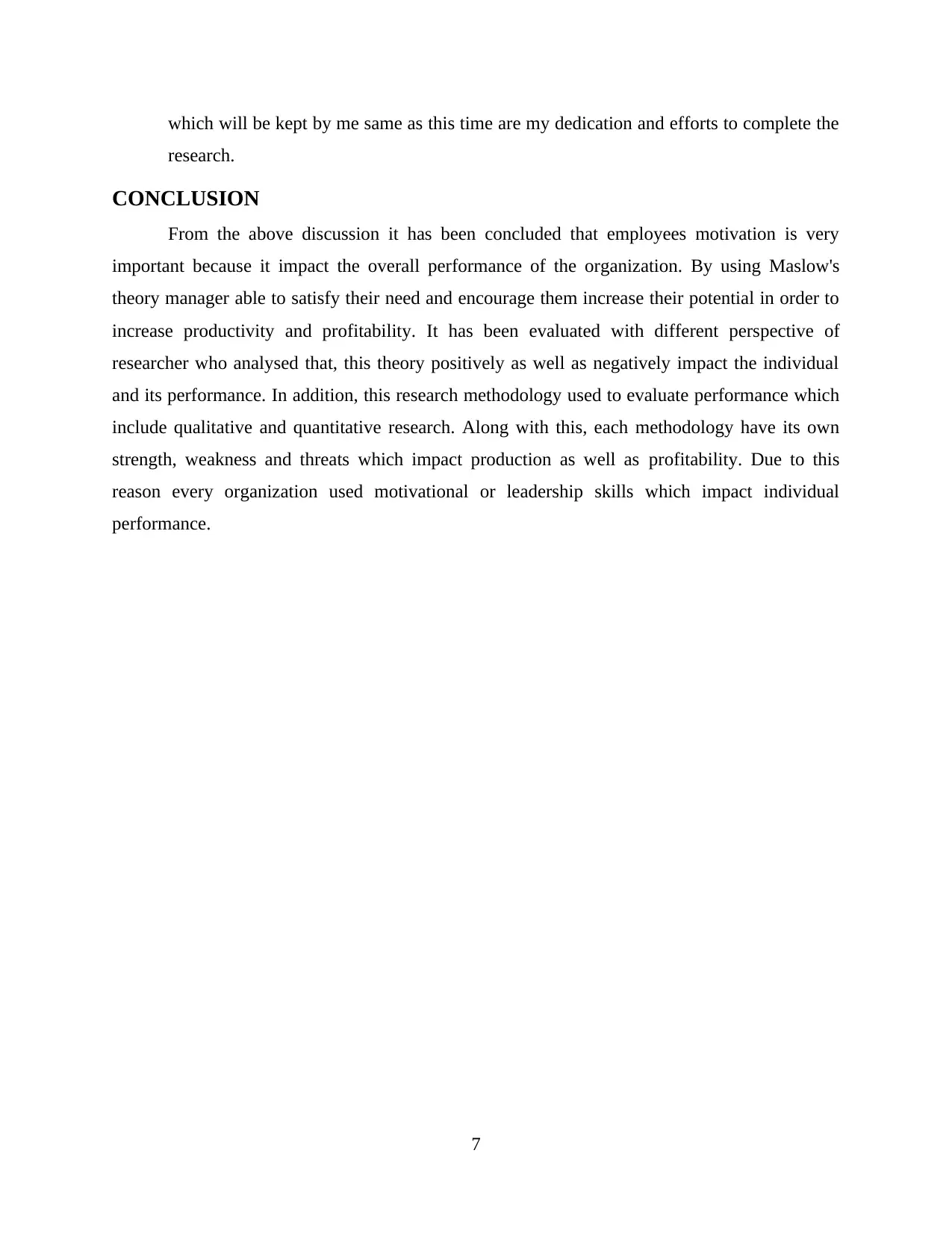
which will be kept by me same as this time are my dedication and efforts to complete the
research.
CONCLUSION
From the above discussion it has been concluded that employees motivation is very
important because it impact the overall performance of the organization. By using Maslow's
theory manager able to satisfy their need and encourage them increase their potential in order to
increase productivity and profitability. It has been evaluated with different perspective of
researcher who analysed that, this theory positively as well as negatively impact the individual
and its performance. In addition, this research methodology used to evaluate performance which
include qualitative and quantitative research. Along with this, each methodology have its own
strength, weakness and threats which impact production as well as profitability. Due to this
reason every organization used motivational or leadership skills which impact individual
performance.
7
research.
CONCLUSION
From the above discussion it has been concluded that employees motivation is very
important because it impact the overall performance of the organization. By using Maslow's
theory manager able to satisfy their need and encourage them increase their potential in order to
increase productivity and profitability. It has been evaluated with different perspective of
researcher who analysed that, this theory positively as well as negatively impact the individual
and its performance. In addition, this research methodology used to evaluate performance which
include qualitative and quantitative research. Along with this, each methodology have its own
strength, weakness and threats which impact production as well as profitability. Due to this
reason every organization used motivational or leadership skills which impact individual
performance.
7
⊘ This is a preview!⊘
Do you want full access?
Subscribe today to unlock all pages.

Trusted by 1+ million students worldwide
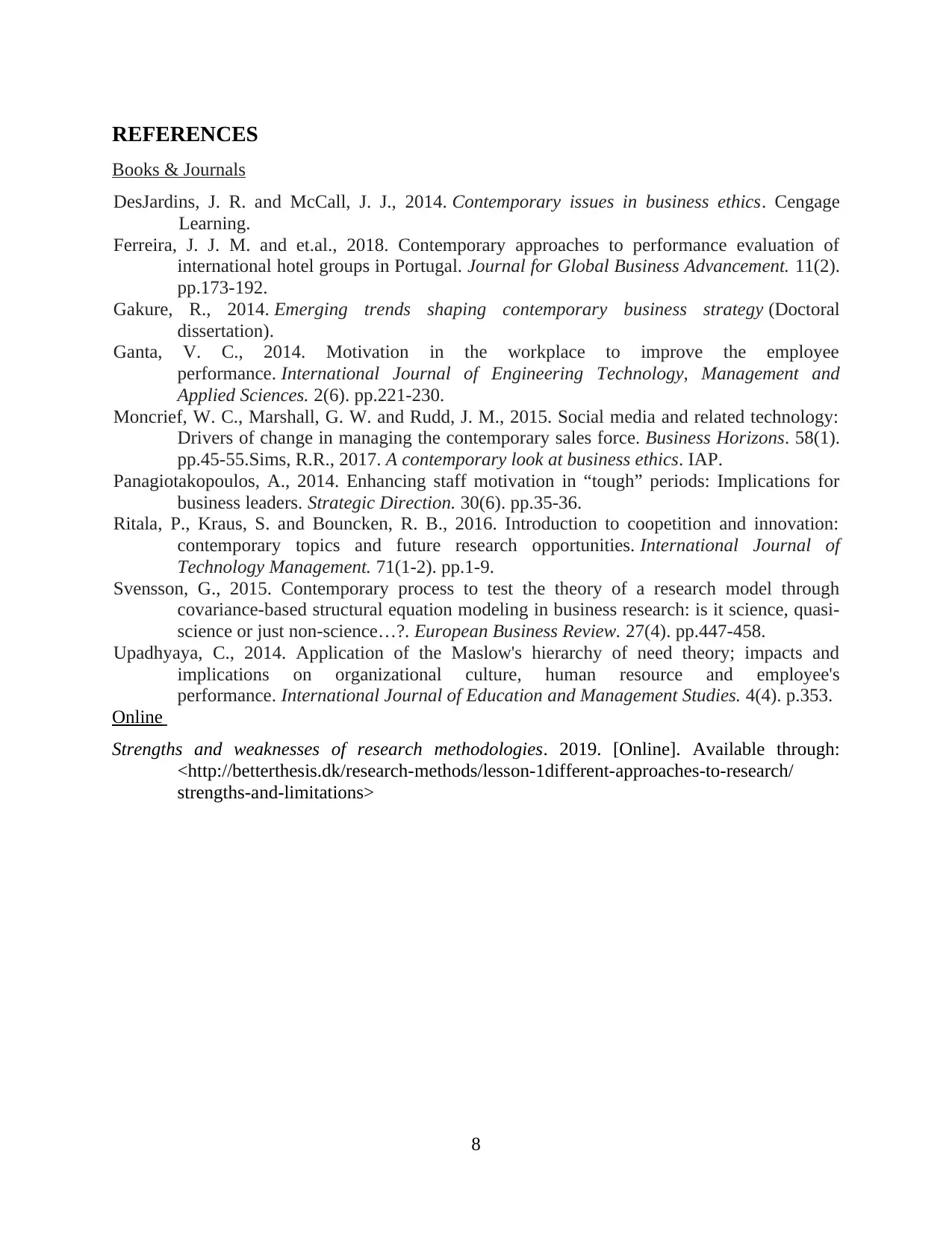
REFERENCES
Books & Journals
DesJardins, J. R. and McCall, J. J., 2014. Contemporary issues in business ethics. Cengage
Learning.
Ferreira, J. J. M. and et.al., 2018. Contemporary approaches to performance evaluation of
international hotel groups in Portugal. Journal for Global Business Advancement. 11(2).
pp.173-192.
Gakure, R., 2014. Emerging trends shaping contemporary business strategy (Doctoral
dissertation).
Ganta, V. C., 2014. Motivation in the workplace to improve the employee
performance. International Journal of Engineering Technology, Management and
Applied Sciences. 2(6). pp.221-230.
Moncrief, W. C., Marshall, G. W. and Rudd, J. M., 2015. Social media and related technology:
Drivers of change in managing the contemporary sales force. Business Horizons. 58(1).
pp.45-55.Sims, R.R., 2017. A contemporary look at business ethics. IAP.
Panagiotakopoulos, A., 2014. Enhancing staff motivation in “tough” periods: Implications for
business leaders. Strategic Direction. 30(6). pp.35-36.
Ritala, P., Kraus, S. and Bouncken, R. B., 2016. Introduction to coopetition and innovation:
contemporary topics and future research opportunities. International Journal of
Technology Management. 71(1-2). pp.1-9.
Svensson, G., 2015. Contemporary process to test the theory of a research model through
covariance-based structural equation modeling in business research: is it science, quasi-
science or just non-science…?. European Business Review. 27(4). pp.447-458.
Upadhyaya, C., 2014. Application of the Maslow's hierarchy of need theory; impacts and
implications on organizational culture, human resource and employee's
performance. International Journal of Education and Management Studies. 4(4). p.353.
Online
Strengths and weaknesses of research methodologies. 2019. [Online]. Available through:
<http://betterthesis.dk/research-methods/lesson-1different-approaches-to-research/
strengths-and-limitations>
8
Books & Journals
DesJardins, J. R. and McCall, J. J., 2014. Contemporary issues in business ethics. Cengage
Learning.
Ferreira, J. J. M. and et.al., 2018. Contemporary approaches to performance evaluation of
international hotel groups in Portugal. Journal for Global Business Advancement. 11(2).
pp.173-192.
Gakure, R., 2014. Emerging trends shaping contemporary business strategy (Doctoral
dissertation).
Ganta, V. C., 2014. Motivation in the workplace to improve the employee
performance. International Journal of Engineering Technology, Management and
Applied Sciences. 2(6). pp.221-230.
Moncrief, W. C., Marshall, G. W. and Rudd, J. M., 2015. Social media and related technology:
Drivers of change in managing the contemporary sales force. Business Horizons. 58(1).
pp.45-55.Sims, R.R., 2017. A contemporary look at business ethics. IAP.
Panagiotakopoulos, A., 2014. Enhancing staff motivation in “tough” periods: Implications for
business leaders. Strategic Direction. 30(6). pp.35-36.
Ritala, P., Kraus, S. and Bouncken, R. B., 2016. Introduction to coopetition and innovation:
contemporary topics and future research opportunities. International Journal of
Technology Management. 71(1-2). pp.1-9.
Svensson, G., 2015. Contemporary process to test the theory of a research model through
covariance-based structural equation modeling in business research: is it science, quasi-
science or just non-science…?. European Business Review. 27(4). pp.447-458.
Upadhyaya, C., 2014. Application of the Maslow's hierarchy of need theory; impacts and
implications on organizational culture, human resource and employee's
performance. International Journal of Education and Management Studies. 4(4). p.353.
Online
Strengths and weaknesses of research methodologies. 2019. [Online]. Available through:
<http://betterthesis.dk/research-methods/lesson-1different-approaches-to-research/
strengths-and-limitations>
8
1 out of 10
Related Documents
Your All-in-One AI-Powered Toolkit for Academic Success.
+13062052269
info@desklib.com
Available 24*7 on WhatsApp / Email
![[object Object]](/_next/static/media/star-bottom.7253800d.svg)
Unlock your academic potential
Copyright © 2020–2025 A2Z Services. All Rights Reserved. Developed and managed by ZUCOL.




